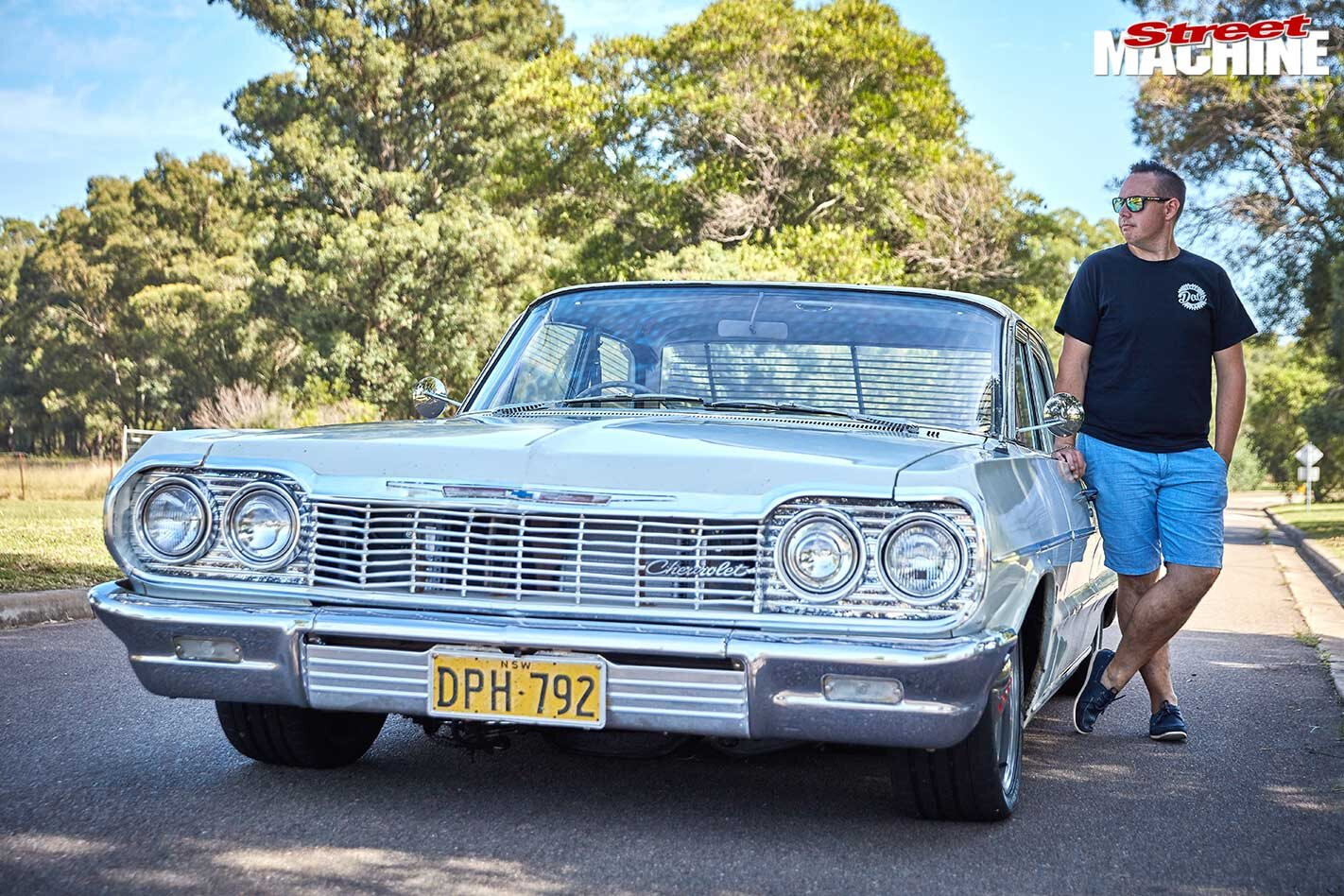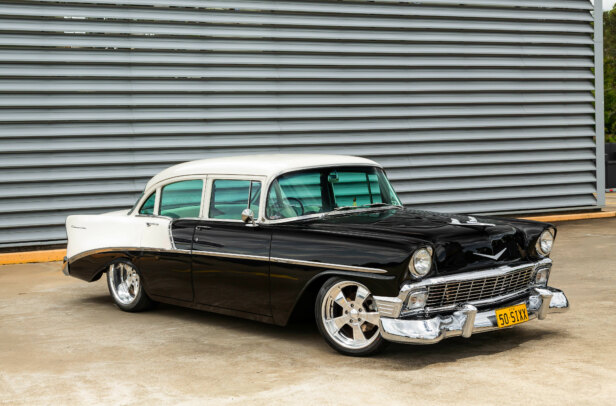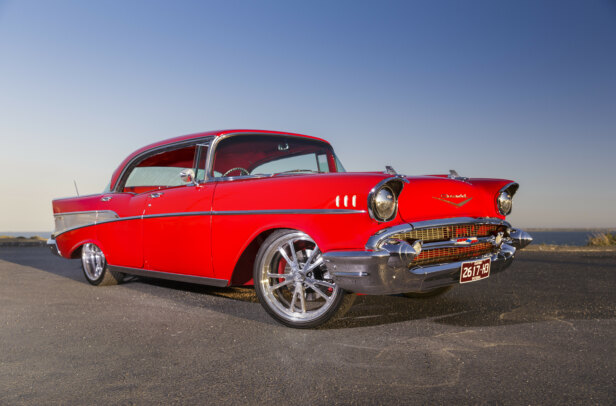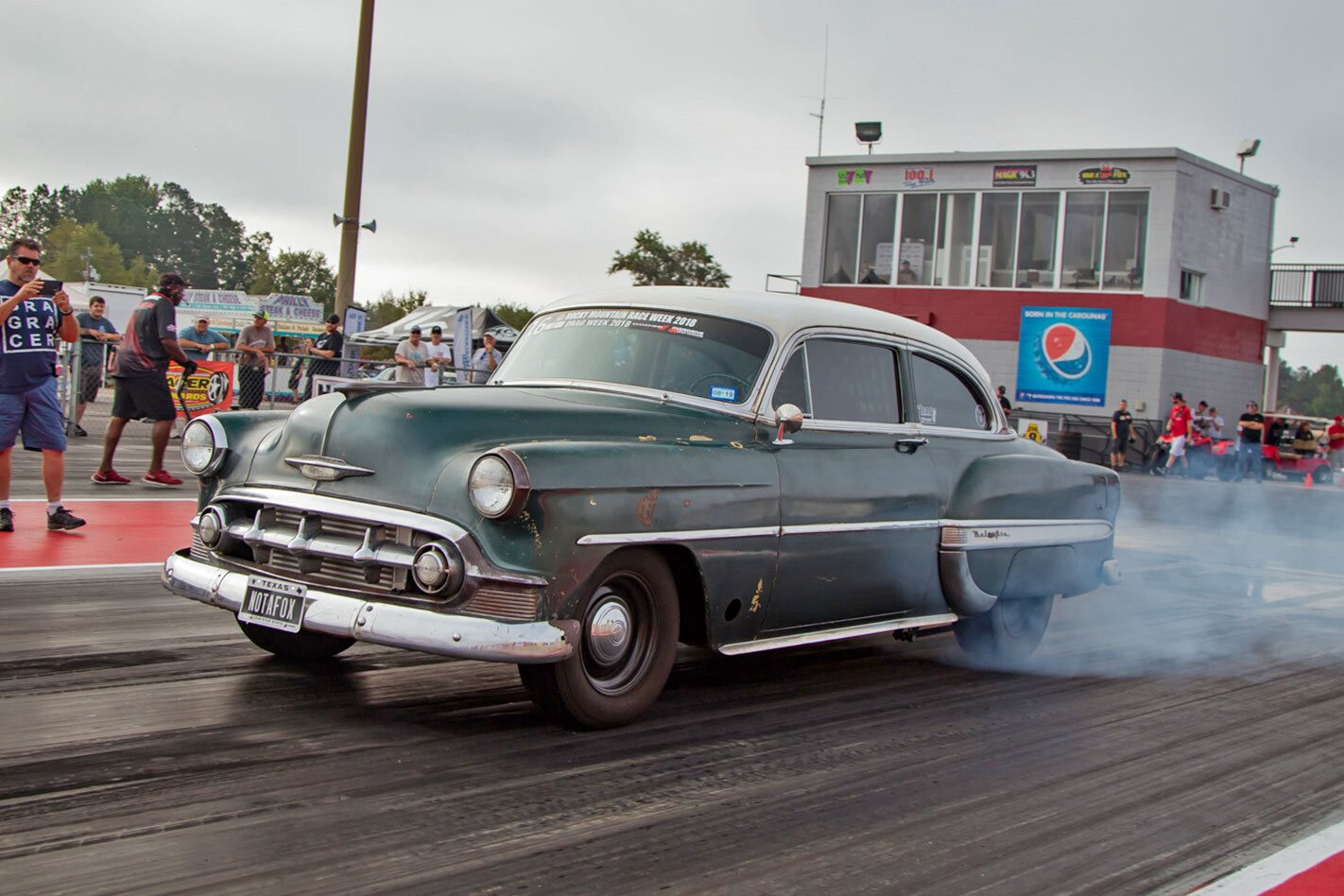GETTING out and driving your project car, and enjoying quality time with your friends and family as they engage with your hobby, is an absolutely primo experience for any street machiner. And it’s one reason smart people put late-model engines into popular old-school platforms like 1960s full-size Chevs.
This article was first published in Street Machine’s LSX Tuner magazine #9, 2019
Sydney’s Mick Vickers is one such smart bloke, taking a clear path with the Aussie right-hook four-door ’64 Chev Bel Air he built into a smooth-running, 400rwhp, air-conditioned family cruiser.
“I bought the car from the original owner in Glen Innes in 2008 as a factory original 283ci/Powerglide car,” explains Mick. “I was 26 when I bought the car with a view to having a fun weekend cruiser for a family one day. Between 2008 and 2019 it was always on the road, but constantly evolving; the snowball effect we are all used to.”
Usability is key for Mick, who loves nothing more than taking the Bel Air to work on Friday. “The best part of the car is I can get in it at a moment’s notice, and cold start out the driveway without waking the neighbours warming up a metered fuel leak for 10 minutes,” he says
Taking a running, driving car and stripping it to its undies for a frame-out, ground-up rebuild is a great way to end up in a world of strife and scope creep.
“My wife Jess is very supportive, even if she can’t work out why I enjoy building something that seemingly causes nothing but stress and swearing from the garage! My eldest son Oliver loves the car, too; he spends hours pretending to drive it while I’m working on it, and nothing makes his week like a trip to Cars and Coffee on a Sunday”
“The swap took about two years, but I did have a child in the middle of that,” laughs Mick. “The theme of the build was to combine the shape and feel of the early-60s cars that I like, with modern performance and ease of use. I didn’t drive it a lot with the 283. If I had’ve mucked around with the carby I could have gotten it a bit better, and it was useable, but it was a pain to live with.”
Mick sourced a GM Gen IV 6.0-litre V8, along with an electronically-controlled 6L80E transmission to give him overdrive cruising capabilities, then set about finding a way to marry the 21st century drivetrain into his mid-20th century right-hand-drive Chevy.
“When I first got the car, LS swaps weren’t as common, but I always wanted the car turn-key reliable,” Mick notes. “Although my first intention was to run a Vortech 350, as time went by LS swaps became more common.
“I mounted the engine using an F-body Camaro sump and a BRP kit for left-hand drive Impalas, which didn’t fit my car, but it was closer than many other options at the time. I didn’t have a forklift at home, so I had the engine delivered to my mate’s shop, and they did some work to it.”
The 6.0-litre retains the stock drive-by-wire throttle and E38 Siemens ECU, while fuel is pushed from a Tanks Inc. fuel tank fitted with an internal Walbro pump. Up front, a PWR alloy radiator keeps the six-point-oh cool, and a custom exhaust from Chris Turner at Castle Hill Performance evacuates gases down to a pair of opening mufflers. “The Varex mufflers mean I can shut the pipes up and keep the neighbours happy,” says Mick
That shop just happened to be the horsepower fiends at Castle Hill Performance, who fitted a CamTech cam and upgraded valve springs.
“My mate Dale Heiler works at CHP, and he recommended the cam as he knew I wanted a bit of a lumpy idle but nothing too extreme. I couldn’t tell you what it is; it just works,” says Mick.
If you believe the internet, adding a big six-speed auto to an early-60s Chevy means cutting the stock trans tunnel out and getting froggy with a welder. Thankfully, Mick chose to do more research on his own.
“To fit the 6L80E I trimmed a little bit of the pinch weld where the back of the bellhousing sits,” he says “I swapped the stock rubber output flange on the back of the auto for a Turbo 400 slip-yoke flange and built a tailshaft from that, as the stock bolt-on flange would not have cleared the stock tunnel.
“We went to bolt the trans and converter to the engine for the final install and the LS wasn’t turning over properly. Dale came over, drank six beers and the next thing was the L98 apart on the garage floor. Pulling it down didn’t reveal a clear cause, but we took the chance to fit new bearings and seals, along with a few preventative pieces like a double row timing chain and new oil pump.”
The refreshed 6.0-litre makes a stout 300rwkW, or over 400hp at the tyres in the old money, but it retains a cammy vibe at idle, runs cool in the summer, and doesn’t stumble on part-throttle. Who could want more?
“It’s a two-tonne barge that doesn’t stop or handle like a race car, so I don’t think I need any more than the 300rwkW it has now,” muses Mick. “I tried to use as many factory parts as possible as I want to be able to pull into Repco and get parts anywhere.”
A nine-inch diff prepared by Speedy Diffs lives out back, filled with snappy 3.7 gears, a Truetrac centre and 31-spline axles, with Commodore disc brakes added to each end. Up front, a Hoppers Stoppers twin-pot Commodore disc upgrade hides behind the fat 20x8in and 20x9in Steelies Wheel Co. wheels, while Air Ride airbags replace coil springs at each corner.
The combo works, too, and sees plenty of action on Sydney streets, as Mick explains: “I drive it everywhere… everywhere that is dry,” he laughs. “It just starts and goes, which is awesome. It used to seem like it took a half-day to get the 283 started and warmed up, and a six-pot Commodore felt like it had more power. It’s so much more of a useable fun car now.”
The cabin is mostly stock, and that is by design. “I went to great lengths to keep the car looking standard in and out,” says Mick. “I’m not a purist obviously, or actively chasing the sleeper look, I just like how they made them back then. Smashing gauges over a full-sweep 60s dash just isn’t for me”
Astoundingly, Mick’s Chev still wears its original Ermine White paint, though he admits it is a bit thin on the edges. “It could probably do with a respray as the paint is original,” he admits. “But I really like the fact it’s 55 years old. Bring your Hyundai to me in 50 years and show me what the paint is like!”
Mick had Dale bring his Vintage Air unit back from the USA in his luggage, then set around making it work. “I fitted it all up and it works great,” Mick says. “I had to mount the evaporator unit backwards as it is designed to be in a left-hook car, so I reversed the mounting so the four air ducts face into the car”
On top of having an ice-cool streeter, another awesome part of the story behind Mick’s Bel Air is the fact he did it with his mates, despite not working in the automotive industry.
“As an IT guy with no formal training in mechanical or fabrication I relied on a bunch of mates to help me along the way,” he says. “I didn’t want them to just do it for me; I wanted to try first and then if I stuffed it up, hospital pass-it for help and to be taught – which is much worse than letting them just do it, so thanks for putting up with me!”
I’m sure you could repay them by ferrying them to the pub for some cold frothies on a Saturday afternoon, Mick!
MICK VICKERS
1964 CHEVROLET BEL AIR
PAINT
GM Ermine White
ENGINE
Brand: GM Gen IV L98 6.0L
Induction: Custom intake, drive-by-wire throttle
ECU: Gen IV Siemens E38
Sump: GM F-body Camaro/Firebird
Fuel system: Walbro pump, Tanks Inc. EFI fuel tank
Cooling: PWR alloy radiator
Exhaust: Custom extractors, 2.5in exhaust, Varex mufflers
Ignition: Factory
TRANSMISSION
Gearbox: 6L80E electronic six-speed auto
Converter: Stock 6L80E
Diff: 9in, Dutchman 31-spline axles, Truetrac centre, 3.7:1 gears
SUSPENSION & BRAKES
Front: Air Ride bags, Monroe shocks
Rear: Air Ride bags, Monroe shocks
Brakes: Hopper Stoppers twin-pot Commodore discs (f), Commodore discs, single-pot calipers (r)
Master cylinder: Wilwood 1in booster
WHEELS & TYRES
Rims: Steelies Wheel Co.; 20x8in (f), 20x9in (r)
Rubber: Falken; 245/35 (f), 265/30 (r)
THANKS
My wife Jess and the boys for their support and tolerance of my hobby; Rusty, Tos and Rody for the help on the car over the years; Jimmy from Speedy Diffs for the advice and perfect diff to suit the needs of the car; Justin from Ultimate Conversion Wiring for sorting the loom and put up with my questions while I fitted and wired it into the car; Craig Weller from A.C Mobile Auto Air for the parts knowledge to piece the remaining air-con pieces together and crimping my poorly thought-out lines; all the boys at Castle Hill Performance for the use of the engine room and tools to build the motor, the exhaust and the fab work that I couldn’t manage; my biggest thanks goes to Dale from CHP/Tuned by Dale as he is the only guy I know who’d drag a fuel tank and Vintage Air set-up in his luggage through US customs to help a mate out. It’d still be a pile of parts on the garage floor without you, mate!




Comments